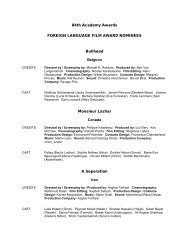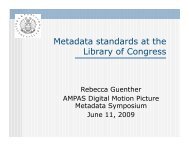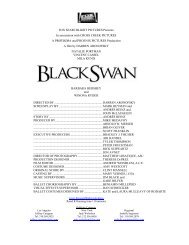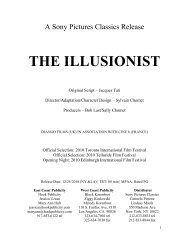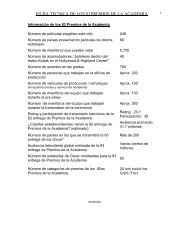Download Report - Academy of Motion Picture Arts and Sciences
Download Report - Academy of Motion Picture Arts and Sciences
Download Report - Academy of Motion Picture Arts and Sciences
You also want an ePaper? Increase the reach of your titles
YUMPU automatically turns print PDFs into web optimized ePapers that Google loves.
We can now apply the various fundamental relationships<br />
we have discussed thus far, to the evaluation<br />
<strong>of</strong> the photographic reflecting power <strong>of</strong> colored<br />
objects. To summarize, the relationships upon<br />
which photographic reflecting power depends are:<br />
(a) The spectral reflection characteristics o{ the<br />
colored object, curvc R.<br />
(b) The spectral distribution <strong>of</strong> energy in the<br />
illuminant, curve J.<br />
(c) The spectral transmission <strong>of</strong> the photographic<br />
objective, Curve C.<br />
-<br />
(d) The spectral sensitivity <strong>of</strong> the photographic<br />
material, curve A.<br />
These various functions are shown by the curves<br />
in I'ig. 14. The {ormal expression for the photographic<br />
reflecting power Rp' <strong>of</strong> the colored object is'<br />
' Arl rcrRrd,<br />
Rp:<br />
l"- z.rc11,<br />
J.<br />
In this expression the symbols A r, J r etc.,indicate<br />
that these values apply to a specific wave-length r.<br />
For correct orthochromatic reproduction <strong>of</strong> a<br />
group <strong>of</strong> colored objects, it is necessary that the photographic<br />
reflecting powers, Ro, shall be equivalent<br />
to the visual reflecting powers, R". It is necessary,<br />
t.40<br />
b r.zo<br />
E<br />
E<br />
z<br />
u t.oo<br />
U<br />
tr<br />
< 0.6<br />
U<br />
c<br />
6 0.G<br />
z<br />
ioo<br />
6<br />
6 o."<br />
5<br />
o<br />
-;><<br />
/l<br />
/.<br />
wavELENGTH (mF)<br />
FIGURE<br />
Spectrophotometric functions involved in the evaluation <strong>of</strong><br />
visual reflection factor.<br />
therefore, to evaluate also visual reflecting power;<br />
<strong>and</strong> the {undamental relationships already discussed<br />
provide the necessary information for this operation.<br />
They are shown graphically in Fig. 15. To summarize,<br />
these relationships are:<br />
(a) The spectral sensitivity <strong>of</strong> the retina (visibility<br />
function, Fig. 7), curve V.<br />
(b) The spectral distribution <strong>of</strong> energy in the<br />
illuminant, curve J.<br />
(c) The reflection characteristic <strong>of</strong> the object,<br />
curve R. The evaluation <strong>of</strong> visual reflecting power<br />
may be expressed in a manner analogous to that giving<br />
the photographic reflecting power, <strong>and</strong> is given<br />
by the following equation.<br />
XV<br />
R,/<br />
J./<br />
I J rVrRrd<br />
J"<br />
f(''- _--<br />
I r-<br />
J rVtdr<br />
Jo<br />
While the use <strong>of</strong> the relationships discussed in the<br />
previous pages are ideal from the theoretical point<br />
<strong>of</strong> view for the determination o{ visual <strong>and</strong> photographic<br />
reflection factors, many difficulties are encountered<br />
in their application to practical problems.<br />
The experimental uncertainties involved in the determination<br />
<strong>of</strong> the various functions are sometimes<br />
so large that the computation <strong>of</strong> reflection factors<br />
by the methods indicated are subject to appreciable<br />
error. It is, therefore, frequently more expeditious<br />
to use a direct method <strong>of</strong> measuring the visual <strong>and</strong><br />
photographic reflection factors o{ the colored objects<br />
in question. However, a thorough knowledge <strong>of</strong><br />
these relationships is absolutely essential to a complete<br />
underst<strong>and</strong>ing <strong>of</strong> hozu <strong>and</strong> zuhy colored objects<br />
are rendered as they are by a specified photographic<br />
technique.<br />
A more direct method <strong>of</strong> measuring photographic<br />
reflection factors has already been discussed<br />
in a previous paper2. The color samples in question<br />
are photographed along with a series <strong>of</strong> grays ranging<br />
from black to white. A typical panel is shown<br />
in Fig. 16.x The horizontal row designated as A,<br />
B, C, etc., are neutral grays having reflecting powers<br />
ranging between 2 <strong>and</strong>, 85 per cent. These values<br />
were measured by the well-known photometric<br />
method. The visual reflection factors <strong>of</strong> the colored<br />
panels can be determined with relatively high precision<br />
by means <strong>of</strong> the flicker photometer method<br />
which is the universally used method for comparing<br />
visual intensities in the presence <strong>of</strong> color difierences.<br />
The negative densities corresponding to the various<br />
gray samples are measured by means <strong>of</strong>, a suitable<br />
densitometer, <strong>and</strong>, by plotting these values as or-<br />
(!r<br />
NI -<br />
s<br />
5@<br />
o<br />
m<br />
1lNl<br />
r5 rr<br />
q<br />
6<br />
2-l<br />
x<br />
I<br />
o<br />
o<br />
z<br />
I<br />
I'<br />
I<br />
I<br />
DENSITY (SPECULAR)<br />
N<br />
o<br />
=<br />
FIGUR,E<br />
XVII<br />
Characteristic log exposure curve <strong>of</strong> photographic material<br />
iliuittati.g method <strong>of</strong> deriving photographic reflection factor'<br />
- ---l<br />
Jot.", Loyd A. The Photographic<br />
-Reflecting<br />
Fower <strong>of</strong>'Colored Objects. Trans. Soc. Mot' Pict'<br />
Ene. XI. No. 31. 564-581. !927'<br />
-*<br />
S.. iilustration on page 44.<br />
Y<br />
t36l





